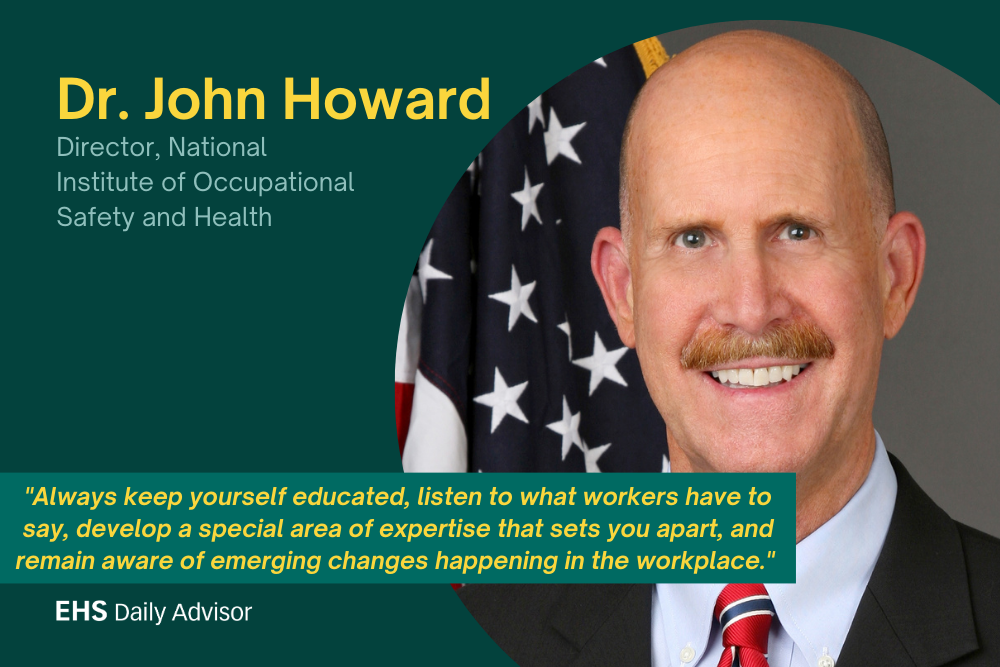Dr. John Howard was trained as a physician in internal medicine, pulmonary medicine, and occupational medicine and worked in clinical medicine until 1991. From 1991 to 2002, he served as the Chief of the Division of Occupational Safety and Health in the State of California’s Labor and Workforce Development Agency.
In 2002, Dr. Howard was first appointed for a six-year term as National Institute for Occupational Safety and Health (NIOSH) Director according to the Occupational Safety and Health Act during the George W. Bush Administration. In 2009, he was reappointed for second and third six-year terms in the Obama Administration, and then reappointed again for a fourth six-year term in 2021 in the Trump Administration.
NIOSH has the mandate from the Occupational Safety and Health Act of 1970 (Act) which established the National Institute for Occupational Safety and Health as a research agency focused on the study of all aspects of worker safety and health. Their mission is “to develop new knowledge in the field of occupational safety and health and to transfer that knowledge into practice.”
For our latest Faces of EHS profile, we sat down with Dr. Howard to discuss listening to workers, advancements in technology, and the future of EHS practice.
Q: How did you get your start in the field?
While a physician, I cared for many workers with occupational illnesses like asbestosis. I wanted to learn more about these conditions and how we could prevent such occupational and environmental diseases. My interest led to my gaining additional training in occupational medicine.
Q: Who has been your biggest influence?
My biggest influences were my teachers at the Harvard School of Public Health, where I trained as an occupational medicine specialist.
Q: What’s your best mistake and what did you learn from it?
I think that the most important source of information about occupational hazards are the stories of workers. Not listening fully and completely to workers can leave you ill-informed about how to approach the cause of an occupational hazard, and the controls needed to prevent injury or illness from a hazard. I have learned many times that listening to those doing the work often leads me to the solution.
Q: What’s your favorite and least favorite part about working in government? Would you change anything?
Working in a government agency has its challenges. Bureaucratic processes often slow down things you would like to speed through, and scientific review often takes longer than you wish. However, you have an opportunity to work with a diverse group of very committed experts who are working hard to address problems affecting our nation.
Q: What are your thoughts on safety culture? How can company leaders make safety a value within their organization?
If companies want to make safety a value in their organization, then safety must become the heart and soul of organizational decision-making. James Reason taught us that an ideal safety culture is “the ‘engine’ that drives the system towards the goal of sustaining the maximum resistance towards its operational hazards” (Reason, Work & Stress. 1998; 12(3):293-306). Safety and health must have a role in every organizational decision—that’s how you make safety an organizational value.
Q: What safety concerns or issues do you think need more prioritization in EHS programs?
One could develop a long list of issues that need to be on a prioritization list. For me, at the top of any list would be the future of EHS practice. New technologies, new organizational designs, new work arrangements, new hazard and risk profiles from emerging technologies are rapidly emerging. Every EHS professional needs to keep ahead of future applications in the workplace.
Q: What will be the impact of Environmental, Social, and Governance (ESG) principles on the EHS industry?
Professional societies like ASSP and AIHA are developing materials, guidance, and educational opportunities about ESG principles and how they can be used to advance worker safety, health, and well-being. I think these activities will have a positive impact on a firm’s understanding of how safety and health can advance ESP principles.
Q: How will new safety technologies influence the work being done by EHS professionals?
Algorithmic management tools, robotic devices, exoskeletons, and other wearable sensor technologies, and as recently seen, the advances seen in generative Artificial Intelligence, like the Chatbot GPT-4 from OpenAI, will influence the work of a number of professions, including EHS practitioners. EHS professionals will be challenged by learning new skills that will enable them to assess and control the new risks arising from these new technologies.
Q: What are you most proud of?
I am most proud of the people I work with at NIOSH. Despite all the challenges that they face, they come to work every day ready to make work safer and healthier for every American worker.
Q: Do you have any advice for people entering the profession?
Always keep yourself educated, listen to what workers have to say, develop a special area of expertise that sets you apart, and remain aware of emerging changes happening in the workplace, to the workforce, and to the way work is done. You will never be bored.

